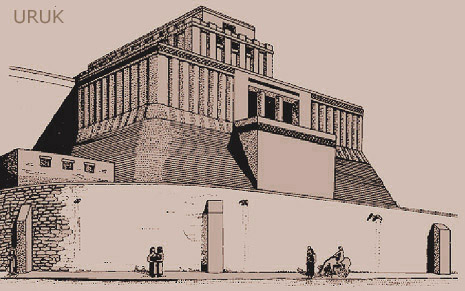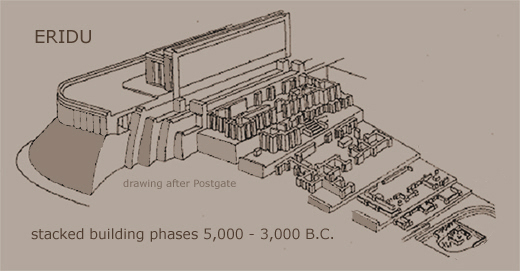Reflections on Prehistory Essays written in 1995.
Mesopotamia is located on the fertile
flood plain of the Tigris and Euphrates rivers in a hot desert ecology.
Human settlements based on irrigation agriculture first appeared
coincident to the establishment of Eridu about 7400 BP. A great stepped
tower, a ziggurat, which culminated a series of 20 structures built one
upon another during a span of 3500 years evidences Eridu's importance.
Public architectural monuments were the focus of early Mesopotamian
community centers. By 6500 BP. large scale canal systems and many towns
with public architecture had been founded. Eridu was the largest.
The Eridu period was followed by the
Uruk, named for its largest and most impressive city. Settled by 6000
BP, Uruk grew to a population of 10,000 within a millennia. A
significant number of developments occur in Mesopotamia during the Uruk
period, including increased economic specialization, the introduction
of metals, and use of beasts of burden, the wheel, cart and implements
like the plow. River based exchange networks existed. Uruk's large and
impressive Anu ziggurat was repeatedly enlarged to become Mesopotamia's
largest.

During the dynastic period (5600 - 5100
BP.) a dozen city states evolved coincident with a widespread
abandonment of rural settlement in the region. The population of Uruk
rose to about 50,000 people and sprawled to cover 450 hectares, making
it the world's first known urban center. Defensive walls around urban
concentrations appeared.
A significant new development during the
Dynastic period was clay tablets with written script dating to 5,400
BP. A developed system with presentation conventions and 1500
ideographic and pictographic elements evolved. The Sumerian symbols can
be equated with the forms of the earlier token convention dated to
10,000 BP. Writing facilitated cultural continuity, community
organization and commodity transaction. During this period, about 5,000
BP., the first recognizable states appeared.
The innovation of irrigation agriculture
made possible human settlement and population expansion in otherwise
inhospitable areas. Mesopotamia exemplifies this emergent phenomena and
provides one of the earliest case studies of a circumscribed marginal
ecology being transformed into a breadbasket supporting large
population centers. Only the Nile river exhibits a parallel situation
and parallel developments during the same epoch. In Mesopotamia the
earliest period of occupation by irrigation based agriculturalists
centers on Eridu. Previous agricultural communities existed in northern
Mesopotamia where rainfall adequate to support crops and domesticated
animals occurs. What is unique at Eridu and other southern Mesopotamian
settlements is a dependence on canal based irrigation, allowing
emergent agriculturalists to adapt to an otherwise inhospitable
ecology.
Irrigation did occur elsewhere prior to
Eridu's settlement. At Eridu irrigation is a community scale
enterprise. The earliest occupational levels include significant,
central public structures that evolved to ziggurats. These structures
remained central to Mesopotamian communities and are probably
reflective of the evolution of community and regional organization
during a continuum spanning millennia. Their constant rebuilding and
enlargement is indicative of their social significance. Their
centrality in the community is not only spatial; they are surrounded by
important architecture like storage buildings and the most palatial
compounds.
Canal works and public architecture
evidence community organization.
Evidence of land control or ownership
systems is more ephemeral. Irrigation works make land more valuable to
the agriculturalist or community, a quality dependent on a capacity to
construct, operate and maintain a spatially complex, elaborate water
transport system. This sort of sophisticated sphere of activity
involves foresight, feasibility understanding, good engineering,
organized construction and, to insure continuity, constant control and
maintenance; in other words a community organization with continuity.
Did communities, families or individuals own the land?

The value added dimension of irrigation
system construction must have altered the way humans interrelated with
land, particularly regarding temporality of ownership. Creators tend to
view their products as property and persons and communities in creating
extensive canal irrigation works became property owners. The ever
larger central mound surmounted with community structures as the locus
of the community area represents a form of deed, evidencing the
community's longstanding claim to the locality.
Today the ziggurats,
tells and canal works remain as evidence from which the archaeologist
works to reconstruct how the complex web of the first civilization and
urban area evolved from a highly successful adaptation of irrigation
agriculture.
The combination of agriculture, complex
large scale irrigation works and community organization was such a
successful adaptation that it sustained 50,000 member urban centers.
The massive ziggurats, manifestations of the community's heritage and
enduring temporality, encase many chapters in the history of the
evolution of Sumerian civilization and statehood. Ziggurats, tells,
canals and defensive walls write history for us today as surely as did
the Sumerians evolve to utilize writing, annote our most ancient
histories and thereby begin to close the door on prehistory.






Kommentáld!